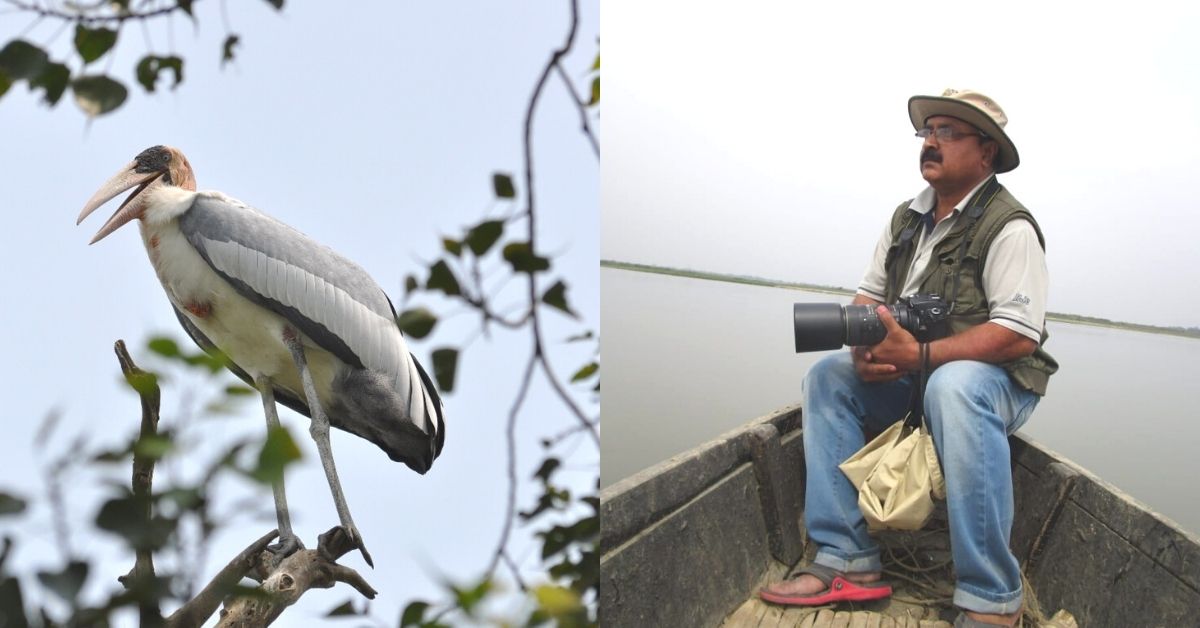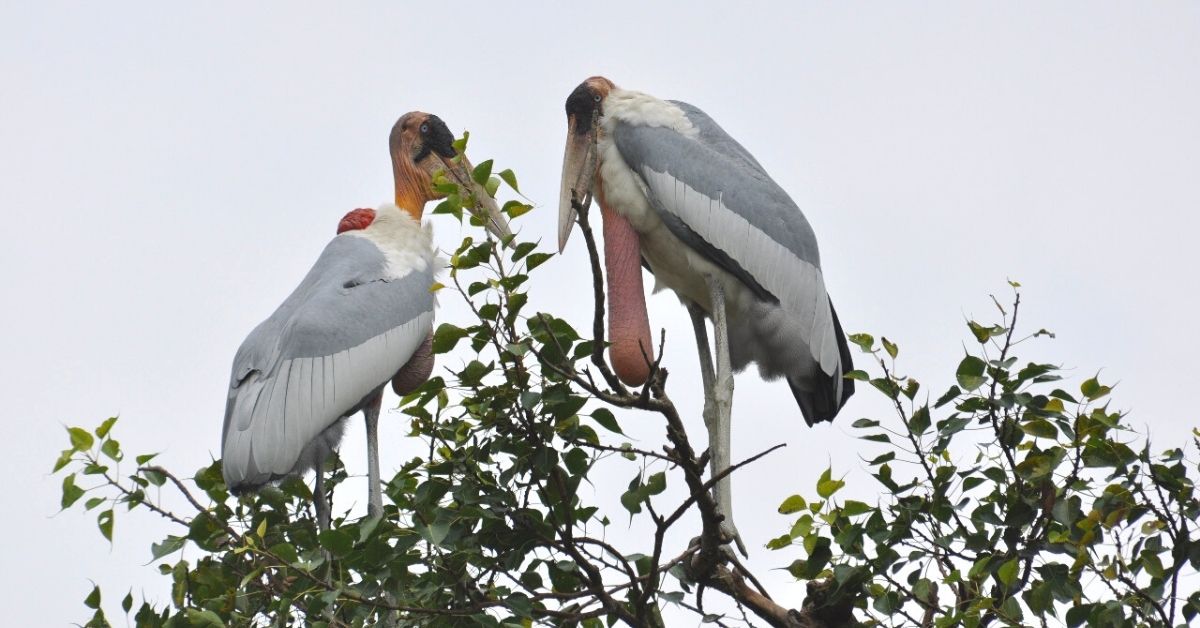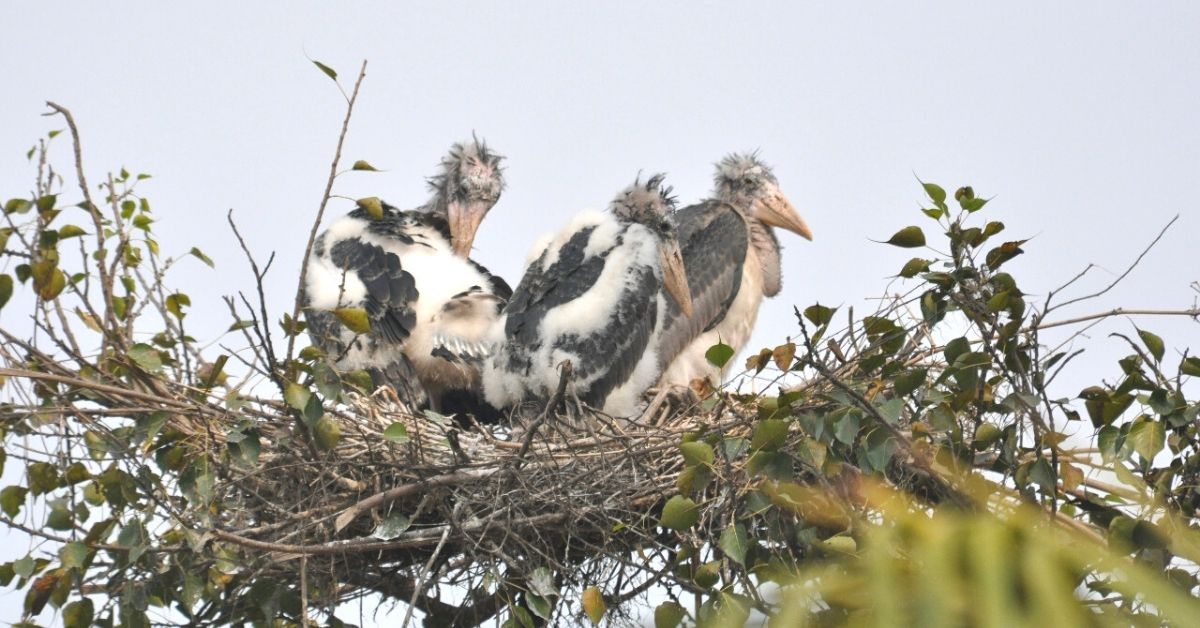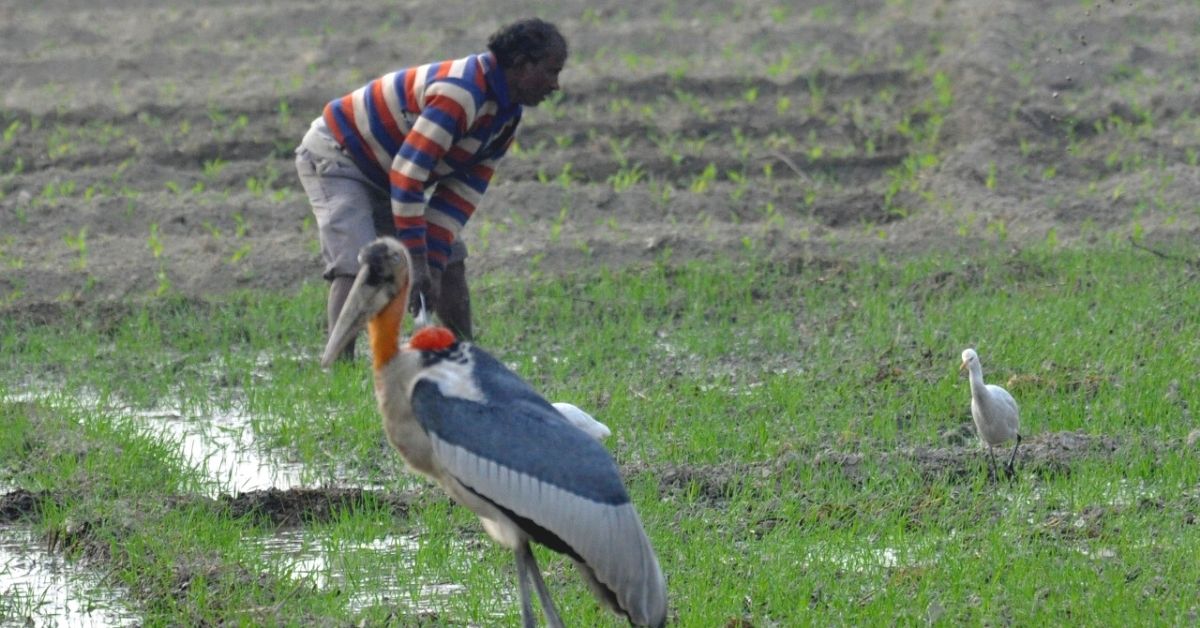Bihar Man Works for 13 Years, Saves the Greater Adjutant Stork From Extinction!
Arvind Mishra, from Bhagalpur of Bihar, formed the Mandar Nature Club to save the Great Adjutant Stork from near extinction and created a safe habitat for the species with the help of locals

In October 2006, Arvind Mishra, a wildlife conservator received information about a potential new species of birds spotted in Bhagalpur district of Bihar. The tip came from a local wildlife expert and friend Jai Nandan Mandal, and the enthusiast rushed to take a look at the bird.
Reaching the flood plains of the Ganga Diara, he saw two pairs of the bird species that appeared to be bald with penetrating white eyes, a red pouch, white feathers around their neck and dark wings. It took no time for the expert to identify the 1.5 meter tall and beautiful looking bird known as Greater Adjutant Stork.
“I noted the date as 26 October 2006 and the friend accompanied me. The birds were nesting and incubating eggs on a Semal tree, sharing the space with seven nests of Lesser Adjutant Stork (Leptoptilos javanicus),” says 61-year-old Arvind.
The Great Adjutant Stork (Leptoptilos dubius), locally referred to as Garuda, is enlisted as an endangered species under the International Union for Conservation of Nature’s (IUCN) Red List. It is classified, under Schedule IV of the Indian Wildlife (Protection) Act, 1972. Once abundant in Asian countries, the bird species declined rapidly in the 20th century due to hunting and habitat loss. Presently, the species is reportedly found only in Assam, Bihar and Cambodia of South East Asia, with an estimated population of a little over 1,000.
Fighting for survival

Arvind says the bird was not known to exist outside Assam. “It was the first sighting reported, and the sighting prompted me to carry out an extensive search and find the existence of these birds in other areas. The duo surveyed nine districts of Bihar revealing 16 breeding sights and 78 birds by 2007. The birds were spotted, mainly on the Peepal tree of Kosi Diara in Bhagalpur district,” he tells The Better India.
The incident gave Arvind all the motivation he needed to grow from conserving wildlife to conserving bird species as well. And thanks to his conservation efforts that have resulted in an increase of the Greater Adjutant population from a mere 78 to about 600.
“I was working for tiger and other animal conservations across India. However, experts told me to explore Bihar and surrounding regions for birds, as it was a less ventured territory in the late 1990s. Between 1989 and 1990, I moved to Bihar to study about birds and document biodiversity. In 2004, I sighted the Lesser Adjutant and since then I’ve hoped to find the presence of the Greater Adjutant in other areas,” he says.
Arvind says, after sighting the bird in 2007 he submitted a report of his research which was published in a journal of Bombay Natural History Society (BNHS), an Indian wildlife research organisation. He also started identifying the threats faced by the species in the breeding and foraging grounds.
“We identified the major threats were hunting of eggs, chicks and adult birds from the nests by a local nomadic tribal Banpar also, known as Banjara. The other direct threats were from the local community and farmers who considered the birds to be causing a disturbance in their farm,” he says, adding that the farmers complained the birds messed up the area with their excreta, made noises and created a nuisance.
To overcome their problems, farmers shooed the birds away and even fell the trees where the birds nested, thus destroying their habitat. Besides, natural disasters like thunderstorms, incidents of accidental trapping of juvenile birds in fishing nets, poisoning of the birds and lack of safe habitats further weakened their chances of survival.
Arvind initiated conservation efforts through his NGO Mandar Nature Club and focused on community conservation practices. “With my experience in wildlife conservation, I knew that seeking help from an NGO or research organisations to fund the conservation would not suffice in the long term. Community participation was the only way to ensure the survival of the bird species,” he says.
From killers to conservators

Arvind started multiple interventions that included placing nets under the trees, treating injured birds, creating awareness among villagers about the exclusivity and rare occurrence of the species, the legal repercussions of harming the bird and honouring those who came in support for the protection of the birds.
“I faced a lot of flak, and locals even doubted my intentions. There was a lot of crime and illegal activities reported in remote parts of the district. Being an outsider, locals thought I was a police informant, and anti-social or perhaps pretending to conserve the bird to smuggle and sell them in the international market. The locals took a couple of years to trust me and become convinced of my good intentions,” Arvind says.
The wildlife conservator says that to build their trust, he never handled the birds by himself. “I sought help from local farmers if a juvenile bird fell from the nest or got injured. We treated them together and left the bird to fend for itself. But it did not achieve success. At all times, the birds remained in sight of the locals, so as to convince them that I had no ill-motives. Eventually, by 2010, the villagers themselves asked me to pick up the juvenile or injured birds and take care of their survival. The interactions also helped to build emotional connect between the farmers and the bird,” he adds.
Arvind says that in 2015, the state government recognised the efforts of the local community and extended support by setting up a rehabilitation centre for the birds. The birds got rescued, treated and released back into their natural habitat after recovery. The indirect benefit of the initiative meant that it motivated the locals towards the conservation of the bird.
“Once the people started connecting with the bird, they realised the importance of its ecological contribution. There were fewer complaints of snake bites from locals, especially children, who didn’t wander off in tall grasslands where the birds lived. The locals realised that the bird fed on rats and insects in the farm and helped in their agriculture activity as well. The infestation by insects was also less. The farmers and locals felt safer with the presence of the birds,” he says, adding that such direct benefits helped the locals accept the birds and co-exist.
Felicitation programmes to honour the locals helping in conservation efforts helped encourage the locals to participate in more numbers. “Such steps inculcated a feeling of contributing to a greater good. Over the years, their efforts became a small but steady rise to success,” he adds.
How to save a species

Today, the area is the only place in India where all six resident species of storks namely, Greater Adjutant, Lesser Adjutant, Black-necked Stork, Wooly-necked Stork, Painted Stork and the Asian Openbill are breeding. “Within 13 years, the population of Greater Adjutant, in Bihar has increased to nearly 600 in 2021 from just 78 in 2007,” he adds.
As the red data list suggests, its global population in 2008 was 800-1000 and 800-1200 in 2013. The achievement, Arvind suggests, has been possible only due to the bird’s increasing population in Bihar.
Arvind feels saving a species is not a ‘one man job’ and credits the entire success to the locals. “Once the species starts declining, it becomes hard to recover. The revival of species is next to impossible. The efforts made by the local community is the only reason they are safer from the verge of extinction,” he adds.
However, Arvind says their work is far from over. “Having a single established colony in Bihar has its disadvantages. Any major threat to the single colony may wipe out the whole population from the state,” he says.
To propagate the population growth and increase awareness, Arvind’s NGO has started a new initiative in 2019 to rope in youngsters. “We have formed a group called Garuda Saviours and Garuda Guardians. The guardians help in mentoring the younger generations in sensitising them to the species and helping them reach out while the Garuda Saviours play an active role on the field,” he adds.
One such 24-year-old Garuda Saviour, Prince Kumar says he has saved seven Garuda juveniles who fell from branches of trees. “I also explain the importance of the bird to the locals in remote villages and regularly check on the number of nests, eggs, and hatchlings. If needed, necessary interventions are taken by informing locals to reduce disturbance in the area and avoid cutting trees where the birds breed,” he says.
The conservator plans to organise trips for both groups across India to understand bird conservation efforts, challenges faced in each region and the individual species, and draw protection measures by exchanging information.
But for now, Arvind is glad to contribute to preventing the ecological imbalance caused by the decline of the species. “It gives an elated feeling not to see the birds feeding on garbage dumps but thrive on their natural food of animal carcasses in the rivers,” he says.
Edited by Yoshita Rao
If you found our stories insightful, informative, or even just enjoyable, we invite you to consider making a voluntary payment to support the work we do at The Better India. Your contribution helps us continue producing quality content that educates, inspires, and drives positive change.
Choose one of the payment options below for your contribution-
By paying for the stories you value, you directly contribute to sustaining our efforts focused on making a difference in the world. Together, let’s ensure that impactful stories continue to be told and shared, enriching lives and communities alike.
Thank you for your support. Here are some frequently asked questions you might find helpful to know why you are contributing?


This story made me
- 97
- 121
- 89
- 167










